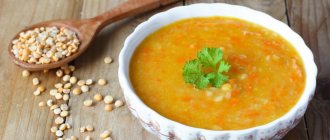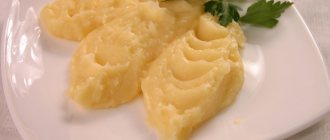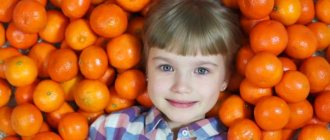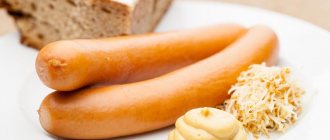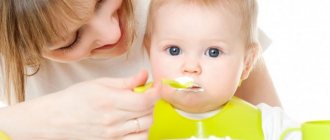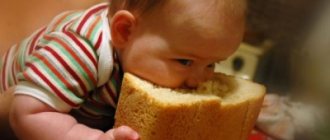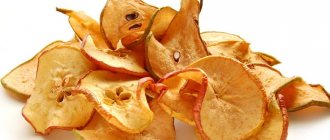Every mother tries to give her child only the best, especially when it comes to children’s menus: maximum vitamins and nutrients! However, the rush to introduce the first complementary foods
to nothing.
the baby’s
digestive system to new foods.
Where to begin? Our mothers, as a rule, started complementary feeding with juices
, but now pediatricians have a different opinion.
In this article we will try to give answers to the most important questions, including how to introduce juice into complementary foods for infants
.
At what age (month) can a child be given juices?
WHO (World Health Organization) recommends not giving juice to children under age
6 months.
If your grandmother or doctor assures you that it’s time to start at 3 or 4 months, these are outdated recommendations. There is no particular benefit for infants in juices. Now it is recommended to introduce fruit and vegetable purees into complementary foods first, and not earlier than 6 months. The fact is that mother's breast milk and modern adapted formulas are able to fully provide the baby with nutrients. Before 6 months, complementary foods can be introduced
only in emergency cases.
The child's age is 6 months, the first teeth are signs that the child has already grown enough and is able to eat adult food. This means that it is necessary to expand your diet. Then you should start introducing fruit and vegetable purees, cereals, and juices into complementary foods.
According to individual indications, clarified apple juice is administered from 3-4 months of age, 3-5 drops. Attention! Freshly squeezed juice is not suitable for 3-4 months of age, since the product’s 100% safety, naturalness and environmental friendliness cannot be guaranteed. For this purpose, there are strict quality certificates for companies providing baby food up to 3 years of age.
Mom's questions:
Is it possible to give juice to a one-month-old baby?
It is not necessary. The baby gets enough fluid, which he gets from his mother’s milk and formula. The digestive system of a one-month-old baby is not yet fully formed; he is not yet able to digest adult food. In addition, in infancy, children often suffer from colic. Introducing juice early may worsen attacks.
Is it possible to give juice to a child under one year old?
Can. Ideally - from 6 months, in emergency cases - from 3-4 months. Apple and pear juices are good for starting complementary feeding.
Which juice to start complementary feeding with?
For the first feeding of infants, single-component juices are more suitable - apple or pear. Clarified, sugar-free.
Read on for more details on these and other issues.
The benefits of apples for children's bodies
I really won't argue here. Apples contain a huge amount of beneficial substances.
This is, for example,
- fiber and pectins, which improve digestion and help remove harmful substances from the body;
- vitamins A, B, C, E, P;
- iron;
- manganese, potassium, magnesium, phosphorus, zinc, copper, chromium, involved in many processes of the body;
- apples normalize hemoglobin, the activity of the nervous system, heart, etc.
But I’ll argue about “enter as much and whenever you want.”
- Firstly, it is better to give an apple to a child no earlier than 6 months (this is the age that is considered optimal for starting complementary feeding);
- Secondly, a large amount of fruit can cause not only flatulence in a baby, but even gastritis;
I would like to draw your attention to one more thing.
- Until recently, pediatricians recommended starting complementary feeding with fruits. But today the situation has changed: now it is advised to introduce the baby to new foods, starting with vegetables or cereals.
It is believed that fresh fruits are very difficult for children's digestive system. In addition, sweet fruits are often blamed for the fact that children do not want to eat anything else after eating them.
Know!
If the main rules for introducing complementary foods are violated or force feeding occurs, the child will refuse any complementary foods. It won’t matter to him whether it’s a sweet apple or buckwheat porridge. He will close his mouth and not eat a spoonful.
To correctly, and most importantly, safely introduce complementary foods and enjoy your baby’s good appetite, watch the online course for children from 6 months to 1 year ABC of complementary feeding: safe introduction of complementary foods to infants >>>
First juices for complementary feeding
Some pediatricians are of the opinion that it is advisable to give the child juices for the first complementary feeding.
factory-produced, others recommend homemade juices prepared by mother’s hands, with care and love.
If we are choosing which juice to start with, then we shouldn’t experiment with something unique. Start with what grows nearby, with simple and high-quality products. Classic juices for first feeding are one-component pear, apple, prune. They are considered hypoallergenic.
Juices are usually divided into clarified and pulpy nectars. First juice
must be clarified, without sugar. Once the clarified one is introduced, we move on to juices with pulp.
Not all juices can be given in the first months of life. Thus, citrus fruits, multifruits, and grape juices are introduced only after 9 months.
Allergic reactions are more likely to occur to brightly colored juices. Such juices include citrus, orange, strawberry, and pumpkin.
With age, a combination of juices becomes useful for children, then the components will complement each other. After the successful introduction of single-component juices, the child begins to be given multi-component juices: pear-apple, pumpkin-apple, apple-prune and others.
Very healthy juices - from beets, carrots and pumpkin.
All orange-colored products contain carotene - it is one of the biologically active substances of growth, prevention of cancer and many other diseases.
A huge problem for children of the 1st year of life is a tendency to constipation. Very often, fruit purees and beet juice can solve this problem.
How to introduce juice into complementary feeding for a baby? Basic Rules
- The volume of juice introduced into complementary foods depends on age.
- Before introducing juice into complementary foods for a baby
, the mother should monitor the baby’s well-being. New complementary foods are introduced provided that the child is healthy. New foods cannot be introduced if the child is sick or after vaccination. - Typically, apple juice made from yellow-green varieties is used for the first complementary feeding. The first dose is only 2-3 drops.
- A new product should be introduced in the first half of the day to monitor a negative reaction if it follows.
- During the day and the next day we look at the skin. If there is no allergic reaction, increase the dose. You can give half a teaspoon or dilute it in a small amount of warm water and give your baby a weak fruit drink.
- It is best to give complementary foods with a spoon or from a cup, but not from a bottle, so that the baby gets used to eating like an adult.
- The juice should be fresh every day. It’s better for mom to drink the rest herself, she also needs vitamins.
- By the end of the first month of administration, the amount of juice reaches 30 ml, by the end of the first year of life - no more than 100 ml per day.
Adult foods should be introduced into a baby’s diet gradually, because new foods often cause allergic reactions. Caring parents should be concerned not only about when the child can be given juices for the first time, but also what kind of vegetables and fruits to choose for this.
Which ones are better to choose for a baby?
There are various types: store-bought and freshly squeezed. Parents decide which ones are best to give to the baby. They differ from each other not only in their appearance and taste, but also in the presence of useful substances in them.
Store
A product is produced that is designed specifically for children, as evidenced by the inscription on the packaging. Also, the age for starting complementary feeding with juice is indicated there. Many people consider store-bought drinks to be very harmful for children, but if you choose a specialized one, it will not have a negative effect on the baby’s body.
Homemade
Products prepared at home should also be treated with great care. Fresh juices have a fairly strong concentration. In an undiluted state, this type will cause more harm to the baby’s body than store-bought sugar containing sugar.
When consuming a freshly squeezed product, it is worth diluting it with water. You should not introduce such fresh juices into the diet until your child is at least one year old.
Allowed fruits and berries for cooking
If you decide to make a drink with your own hands at home, then you should not choose exotic fruits on the store shelf
, berries and vegetables - give preference to those growing in the nearby area where your child was born and growing up. All fruits and berries are allowed for cooking, but you should be more careful about citrus fruits, sour berries, and potential allergens.
Early introduction of juices - benefit or harm?
The main food for children in the first months of life should be natural breast milk, but there are situations when the mother does not have enough milk or it disappears completely. In this case, it would be correct to transfer the baby to artificial formula or mixed nutrition - when breastfeeding alternates with milk or dairy-free formula.
It is recommended to introduce complementary foods into the infant's menu no earlier than six months, but an exception is made for artificial babies, and they can be offered adult food a little earlier - from 4-5 months. It is best with vegetable and fruit purees, they are better digested and accepted by the body without side effects. The next step will be the use of juices (for the first time it is also better to give vegetable nectars, for example, carrot, beetroot).
It is important to remember that babies under one year old can be given vegetable and fruit juices in small quantities. The correct dosage of tasty drinks is the most important aspect when introducing juices and nectars into the diet of a newborn.
Natural juices will bring many benefits to your child:
- strengthening the immune system with healthy vitamins and minerals from natural products;
- addiction to adult products;
- variety of diet;
- increasing the child's appetite;
- identification of allergic reactions, which will prevent irritation in the future.
Based on this, we can say that it is necessary to introduce juices to children under one year old, but it is important to correctly select products for each age and follow the required dosage.
Summary for parents
Before offering freshly squeezed juices to children, especially if they have gastrointestinal problems or a tendency to allergies, you should definitely consult a doctor. For your child to get the most benefit from fruits and vegetables, they should be eaten whole rather than juiced.
Carrots are a food product that is famous for its beneficial properties. There is no organ for which it would not be beneficial. This vegetable is baked, stewed, added to salads, made into juices and purees. To answer the question of whether it is possible to give carrot juice to a baby, you need to understand its properties and effect on the body.
Carrot juice contains many vitamins and nutrients that can restore and support the functioning of many body systems.
Before giving carrots to a child, they should be washed in cool running water and the thin top layer should be removed. Under the skin, in the upper layer, there is a large accumulation of carotene. The part closer to the top contains more vitamins than the tip. It is better not to give the pith to babies, and it should be removed before use. This is where the most nitrates and allergens accumulate.
Carrot juice can treat various diseases. This is an excellent remedy for oral thrush: apply a small amount to the inflamed mucous membrane.
A runny nose can be treated. Freshly squeezed juice is instilled 3 drops into each nasal passage. This dosage is suitable for children under 12 months. To treat nasopharynx in children under 6 months of age, juice diluted with water is used.
How to properly introduce juices into a baby’s diet?
Since the fragile digestive system of children is not yet able to cope with regular food, the process of switching to standard foods takes a lot of time. Firstly, don’t rush things - start offering your baby new products when he himself shows interest in them. Secondly, it is not at all necessary to strictly adhere to the recommended scheme; if a child wants to try adult food at 3-4 months, do not refuse him. There will be no harm if you try to give a curious baby a little puree or a couple of drops of juice; after the first time, monitor the body’s reaction - when everything is in order, you can gradually introduce complementary foods, but if there are rashes or colic, wait a while.
As for juices, you should start introducing them with ¼ - ½ teaspoon of the product at a time. A large amount of concentrated drink is fraught with negative consequences for a baby up to one year old, because juices (especially fruit juices) contain a considerable proportion of natural acids that cause irritation of the oral mucosa and intestinal walls.
The second important point is the optimal ratio of different products in the children’s diet; try to create complementary foods that are as varied as possible, and use only those products to which the baby is not allergic. Along with the introduction of cereals, you can offer infants mixed drinks, for example, carrot-apple, pumpkin-apricot and other juices.
Be sure to dilute your drinks with baby water (it is better to use store-bought distilled water or use filtered liquid). At the same time, never offer foods to a child under one year old without trying them first, because the drink or porridge can be excessively cold or, on the contrary, scalding hot.
How to prepare healthy juices for a newborn at home?
Now everyone has the opportunity to purchase ready-made children's drinks in the store, but it is much healthier and more profitable to prepare a drink for the child at home.
As first drinks, babies under one year old can be given the following juices:
- apple;
- pear;
- peach;
- apricot;
- plum;
- carrot;
- beet;
- squash;
- pumpkin
To prepare natural juice, you can use a juicer, and when you don’t have one, use the old method using a grater and gauze. The process with the juicer is self-explanatory, but with the grater you will have to tinker a little.
First, the fruit should be thoroughly washed and then peeled. Having cut off a small piece, grate it on a fine grater, wrap the resulting pulp in gauze, and squeeze it into a clean container. Since your baby does not require a large amount of drink, a single serving consists of one small piece of fruit or vegetable. The resulting juice is quite concentrated, so it cannot be given to a child in its pure form; the best option is to dilute it with distilled baby water in a 1:1 ratio. The same rule applies to store-bought foods - babies up to one year old should dilute ready-made food and give it at room temperature.
In this way, you can prepare any juices and nectars, but remember that it is permissible to start introducing drinks with pulp only after a year; until this time, it would be correct to filter homemade juices and nectars through a fine sieve or gauze.
Each type of food has its own optimal time for administration. When should you introduce your baby to juices and which one is best to start with?
Homemade recipes by age
When preparing a drink for infants, you should be more attentive and careful, since the baby’s body is not yet fully formed and is more susceptible to the negative effects of the same products than an adult.
Apple
You will need a green apple that does not have any external defects such as spots or dents. Rinse the fruit under running water. Peel, cut out the tail and core. Squeeze the juice by diluting it in a 1 to 1 ratio with water. Start giving your baby in small quantities and no earlier than 5 months.
Carrot
Peel the vegetable by rinsing under running water. Discard the bottom, tops and core. Leave in water for 2-3 hours. Squeeze the juice out of the soaked carrots. Just like with apples, start complementary feeding with carrots no earlier than 4-5 months.
From pear
The first among complementary feeding products is also pear juice for babies. Wash ripe, blemish-free, soft fruit under running water. Remove the unnecessary tail and core of the pear. Squeeze the fruit, diluting it with water in the same ratio as apple.
When should it be entered?
In Soviet times, juices were introduced very early and very first - literally from 3 months. Now the timing of infants’ introduction to this product has moved into the second half of the year. Nutritionists considered that juices are of low value and are often poorly tolerated by the digestive and immune systems of infants. But after 6 months, the child’s body is already quite ready to start taking juices and assimilate them without negative consequences.
It is better to start introducing store-bought juices into the baby’s diet when he has mastered one of the main types of complementary foods: cereals, fruit or vegetable purees. At the same time, artificial babies are offered this product earlier than babies on breastfeeding - after 4 months. It is better to give breastfed children juice after six months, since their body, which receives enzymes from mother's milk, is poorly adapted to the production of its breaking down elements.
A number of pediatricians are generally inclined to introduce juices only after a year, in order to avoid their negative impact on the gastrointestinal tract of infants. In addition, this product, in essence, is quite “empty” - it does not contain as much fiber, vitamins and elements as a baby needs, so early introduction of the baby to the drink, associated with indigestion and allergies, seems inappropriate.
The decision to start introducing a product into the baby’s menu will be made by your pediatrician, based on the baby’s health status, success in assimilation of fruit purees, and what kind of feeding the baby is on.
conclusions
If you decide to start introducing juice into your baby’s diet and summing up the information given in the article, we will highlight 3 main points that must be followed:
- Before introducing complementary foods, you should consult with your local pediatrician, who will tell you about the best options for your child and how to behave if an allergic reaction is detected.
- It is strictly forbidden to give such complementary foods if the baby has just suffered any illness or has had a routine vaccination.
- The baby will be more interested in complementary feeding if you give it from bright and beautiful baby dishes - spoons and bottles.
In addition, you can learn more about the timing of the first complementary feeding for a child, as well as where to start, from the video:
Is this such a difficult question, you might ask? Apples are the safest and healthiest product, so you can start complementary feeding with them, right from 5 to 6 months: give the baby fresh, boiled puree or juice.
But here you are fundamentally wrong. There are many pitfalls even in the “Apple” issue. Let's figure it out: when is a child given apples and apple juice and why.
Benefits of juices
These are sources of natural vitamins, organic acids and microelements beneficial for the baby. Even though the drinks contain very little of all these substances to cover the daily requirement, they are still very useful for babies to drink.
Juices with pulp, in addition to all of the above, contain dietary fiber that is beneficial for the digestive system and pectins. The value of the drink also varies depending on what fruits or vegetables are used as its basis.
- Apple juice contains a lot of vitamin C and is also rich in iron. It helps strengthen the immune system and improves the elasticity of the walls of blood vessels. As a rule, apple juice in our country is introduced into the diet of children under one year of age very first, from 4-6 months, since it is less allergenic.
- Pomegranate juice is rich in iron, it is useful for anemia, as well as for improving metabolism.
- Peach, carrot, pumpkin and apricot juices are rich in beta-carotene, which is good for your baby's eyes, bones, teeth and gums.
- Pumpkin juice contains B vitamins that are useful for children’s metabolism. Also, these elements are important for the functioning of almost all systems of the baby’s body.
- Apricot and banana juices will enrich cells with beneficial potassium and magnesium.
With the help of natural drinks, you can easily regulate your baby’s stool: plum, peach and apricot have a laxative effect, while pear and pomegranate, on the contrary, strengthen it.
Store-bought or homemade?
Purchased juices intended for children under one year old undergo mandatory quality testing; in addition, they do not irritate the gastrointestinal tract of babies, as they have a balanced acid composition. But due to heat treatment, they lose half of their value, and during transportation or storage, the integrity of the packaging may well be compromised, causing the product to deteriorate ahead of schedule.
Homemade fresh juices retain all the value of the fruits and vegetables from which they are made, but are also very concentrated. In order not to make things worse and not cause a negative reaction from the gastrointestinal tract in children, it is recommended to dilute them twice with boiled water.
In what order should I enter?
- The very first child is usually given apple juice - it is less allergenic. It is better to use ripe green fruits or purchase a clarified product for feeding children from 4 to 12 months.
- When the baby tastes the apple drink, you can offer him clarified pear, carrot, pumpkin, apricot, peach or banana juice in any order.
- Next, you can start combining the juices you have mastered by purchasing or creating mixed drinks. It would be good to make a fruit and vegetable mix by mixing apple and pumpkin, carrot and pear products.
- When the baby gets used to mixed drinks, you can start giving the child red-pigmented foods: cherry, sweet cherry, plum, blackcurrant and cranberry. Among vegetable drinks for babies prone to constipation, beetroot will be useful.
- Children are introduced to citrus, tomato, strawberry and grape drinks last: at 12-15 months, since some of them are highly allergenic, while others contain a large amount of fruit acids.
Some nuances
Freshly squeezed juice should be consumed no earlier than an hour after eating and no later than 15 minutes after preparation.
Even an older child can be given fresh apple juice only in small quantities, since it contains a lot of fruit acids and can increase the acidity of gastric contents. A baked apple is much healthier for a child.
In order for the carotene contained in the fresh juice to be absorbed, you need to add a spoonful of cream to the drink or give it to your child along with a piece of bread and butter.
How to enter?
- It is better to introduce juice into your child’s diet in the morning, this way you can monitor the negative reaction throughout the day;
- on the first day, the baby should be given a few drops of the drink on a spoon after feeding;
- in the first week the child should be given 0.5 tsp, in the second - a whole, in the third - 2 tsp, etc.;
- a one-year-old child can be given no more than 60 ml of drink per day;
- Each new type should be given to the child “like the first time” - a few drops, gradually increasing the volume of the unfamiliar drink in feeding.
If vegetable and fruit purees have already been introduced into your toddler’s complementary foods, the doctor will advise you not to rush with juices. The fact is that the child already receives all the substances he needs, which are contained in vegetables and fruits. Moreover, there are much more of them in purees than in juices, especially clarified ones, which practically do not contain fiber useful for digestion.
Fruit juices are introduced into complementary feeding for bottle-fed babies from about 8-9 months, and when breastfeeding even later - from 11-12 months. All juices are started to be given to the babies, taking into account their individual tolerance, as well as based on the child’s reaction. That is why the first portion should consist of only a few drops of juice.
Pediatricians recommend starting with a green apple, grown in the region where the baby lives, for example, with the Simirenko or Antonovka varieties. After all, scientists have long proven that at the cellular level, local vegetables and fruits are absorbed better than overseas ones, do not cause an allergic reaction and contain more vitamins, because imported fruits lose them along the way.
Complementary feeding for babies: clarified fruit juices
The first fruit juices should be clarified. It doesn’t matter that they contain fewer vitamins than juices with pulp. But they do not irritate the mucous membranes of the stomach and intestines so much, which is why the juice cannot be completely absorbed.
If you decide to give your baby homemade fruit juice, then after squeezing, strain it again through several layers of boiled gauze to get rid of excess pulp.
Your toddler may not like sour fruit juices, and because of this, he will not want to drink them again. But still do not add sugar to juices. These are extra calories that are stored as fat and cause excess weight.
It is better to choose sweet apples and pears for baby juice. Fruit sugar in small quantities is good for brain function and saturating the body with valuable carbohydrates.
How to introduce fruit juices with pulp into complementary foods
When your baby gets used to clarified fruit juices, start introducing juices with pulp into complementary foods. Just keep in mind that they must be homogenized, that is, crushed. Others will not be absorbed by the baby's body.
From fruit juices with pulp, choose pear, apple, plum, and apricot.
Tender plum pulp envelops the gastric mucosa and has healing effects. Plums also contain a lot of potassium, which strengthens the heart muscle.
Apricot juice is beneficial because it contains iron, carotene and calcium. This combination is beneficial for the hematopoietic system: half a glass of juice can replace a serving of beef liver. Potassium, which is also abundant in apricots, is necessary for the functioning of the heart. But keep in mind that apricot juice activates peristalsis, so give it to a baby with normal stool no more than once a week.
It is better not to offer citrus juices to babies under one year of age, as they are quite a strong allergen. And other exotic juices are not beneficial for infants for the same reason. Moreover, some fruits do not react immediately, but only as allergens accumulate in the body.
Grape juice is also not intended for infants, because it causes flatulence.
Juices from berries are tasty and aromatic, but pediatricians usually recommend eating the berries rather than making juice from them. The fact is that whole berries, in addition to vitamins, contain pectin and fiber that are useful for the gastrointestinal tract, but berry juices do not contain them.
We begin to introduce vegetable juices into complementary foods
Vegetable juices - carrot, pumpkin, tomato - should appear in the toddler’s diet no earlier than he turns one year old.
Provitamin A, or carotene, which is contained in carrot juice, improves vision and generally has a positive effect on the growth of a child. Just remember that vitamin A is fat-soluble, so you should add a few drops of cream or vegetable oil to carrot juice.
Pumpkin juice also contains carotene. In addition, it contains vitamin D, which prevents rickets. Therefore, this juice is very useful in winter, when there is little sun. And due to the high content of B vitamins, it is recommended for hyperactive children.
Give tomato juice in diluted form after a year, as its pectins irritate the delicate mucous membrane of a child’s stomach. But it does contain the powerful antioxidant lycopene, which is important for children living in unfavorable environmental conditions.
Complementary foods for babies: mixed fruit and vegetable juices
If the baby digests fruit and vegetable juices well separately, he can be given multi-ingredient drinks. For example, if you mix carrot and apple juices, then in addition to vitamin A, the child will receive vitamin C (just don’t forget to add a drop of cream or olive oil).
It is also advisable to offer the baby juices from two or three types of fruits, for example, apple-banana-apricot. It contains a whole set of vitamins - C, A, E, PP, as well as many microelements: iron, potassium, magnesium. This juice will strengthen the heart, improve the functioning of the circulatory system, cleanse the intestines, and also have a beneficial effect on digestion, since the tender banana pulp has a beneficial effect on the stomach.
Expert opinion on fruit and vegetable juices in complementary feeding for children
Yulia Kosareva, pediatrician, Moscow
Freshly squeezed juices are useful because they retain all the vitamins. But, on the other hand, they act too aggressively on the baby’s delicate digestive system. They contain a lot of fruit sugars, which can negatively affect the functioning of the pancreas. Therefore, such juices need to be diluted with regular drinking water.
In addition, live juices cannot be stored for a long time: after two hours, even in the refrigerator, they begin to ferment, and such juice can no longer be given to the baby. For the same reason, freshly squeezed juices are not taken on the road.
Among industrially produced juices, directly pressed juices are useful, since they are squeezed from fruits, immediately pasteurized and packaged.
But drinks made from concentrated juice with the addition of water, so-called reconstituted, are less healthy. True, they last longer, but they contain very few vitamins and contain artificial preservatives. This is why pediatricians do not recommend giving reconstituted juices to young children, especially infants. Only special directly squeezed children's juices are recommended for them, which should be indicated on the packaging.
- To ensure that your little one benefits from a vitamin drink, follow the simple recommendations of experts.
- The first time after introducing pear and apple juices into complementary foods, they can be given four times a week. Start with a few drops and, if everything goes well, increase the amount of juice to a teaspoon, then to a tablespoon, and then to 100 g. By the age of one year, the baby can drink 200 g of juice during the day.
- Remember that juice is a healthy addition to the main diet, and the main drink for a child throughout the day is clean water.
- Juices should not be given to your baby immediately after meals. It is best to give them as a separate meal, such as an afternoon snack. Moreover, juices go well with unsweetened cookies and crackers. In this kit, the child will receive carbohydrates that will fill him up and keep him active until dinner, as well as valuable vitamins and minerals.
- The baby's first juices should be apple and pear. Apples contain a lot of iron and vitamin C, and pears are rich in vitamins A, E, C, PP, as well as minerals - zinc and copper. But pear has a strengthening effect. For this reason, it is better to offer it to children with a tendency to loose stools. An apple, on the contrary, activates digestion and is therefore preferable for constipation.
With the birth of a baby, parents have many questions about proper and healthy feeding. There is advice from friends, relatives, and acquaintances floating around: some say that juices can be given already in the first month after birth, others, on the contrary, are against this drink for up to a year. In any case, you need to take into account the fact that all babies are completely different, and it is impossible to predict how the body will react. In any case, you should consult with your pediatrician when apple juice can be given to your baby.
Modern doctors do not recommend introducing juices into complementary foods too early. Despite the fact that these drinks are indeed healthy and nutritious, it is better to be late with the introduction than to hurry. During the first months, he receives all the necessary substances and vitamins for the baby’s growth and health promotion through mother’s milk. It should be remembered that the juice contains acid, which can injure the baby’s fragile stomach; first, you should introduce him to such a treat as porridge. They are more harmless than nectars and also have nutritional properties.
There are situations when the mother does not have milk or has very little milk. In this case, the child does not receive proper nutrition and naturally remains hungry. Then you have to switch him to artificial complementary feeding. When a child is kept on such a diet, the gastrointestinal tract is better prepared for various types of complementary foods (cereals, juices, vegetables, fruits) and at an earlier stage than with breastfeeding. Of course, nothing can replace mother’s natural breast milk; there is nothing better for the health, strengthening of the child’s body and immunity.
When breastfeeding, it is better to start feeding with vegetable purees. They are lighter and more easily digestible. Homemade purees made without sugar and salt will be the healthiest. Having assessed the baby’s reaction, you can proceed to the next step - introducing juice into the diet.
Pediatricians will tell you which juice to start complementary feeding with, but traditionally clarified nectars from green apples are given first.
When introducing juices and purees, it is necessary to carefully monitor the baby’s body reaction. If there are negative aspects, such as rash, itching, redness, indigestion, immediately stop giving these products and consult a specialist.
It is necessary to correctly introduce permitted foods into the baby’s diet, thereby he will receive a lot of benefits. :
- improve digestion,
- strengthen the immune system,
- increase appetite,
- fill the body with useful minerals, vitamins, acids,
- remove harmful substances from the body,
- have a positive effect on the cardiovascular system,
- improve your mood and give you more strength.
For the first two to three months after the baby is born, the best food for him is breast milk. The baby is growing, the ventricle is strengthening, and accordingly, it can process more complex products than milk. In addition, it alone is no longer enough for the further development of the body. From now on, you can give your baby porridge, purees, and juices to try while breastfeeding.
How and when are apples given to a child?
Here everything greatly depends on the complementary feeding scheme and the principles that you adhere to. Below I will describe the classic scheme, and we discuss the intricacies of introducing foods in detail on the ABC of complementary feeding.
- It is better to give the first spoons of complementary foods monocomponent;
It is easier for the body to assimilate and it is easier for mom to identify the source of allergies or bloating. After 7 months, two components can be combined.
Around 7 months, you can already give your baby raw grated apple.
- In order not to cause a child’s protest when introducing a new product, you should follow the rule: complementary foods are introduced with the aim of introducing the baby to new food, and not replacing milk with it;
- Portions of complementary foods should be small (starting with a quarter of a teaspoon, gradually increasing. The rest of the food will be breast milk (or formula);
- For the same purpose, complementary foods are made quite varied: we add new foods once every 3-7 days.
With this approach, the baby will be happy to try vegetables, cereals, and meat.
Important!
Apples cannot be the main source of nutrition for a child under 1 year of age. This is a wonderful dessert and snack, but you won’t get far on apples alone.
Apples can be given in grated or pureed form, and at the age of 9-10 months we begin to teach the baby to bite off pieces and chew them. Everything is strictly under mom's control.
Again, we discuss how to give pieces of apples and safety precautions in the ABC of complementary feeding course. The issue is important and cannot be ignored.
We’ll talk about how to introduce apple juice into complementary foods below: this topic also has its own nuances.
How to cook baked apples for a baby?
For children prone to constipation or frequent bowel movements, you can try temporarily replacing fresh apples with baked ones.
- Processing reduces the acidity of the fruit. It not only becomes sweeter: fermentation processes are reduced, which prevents gas formation;
- A soft product, consumed warm, is easier to digest and assimilate without overloading the small stomach;
- The amount of fiber in such an apple is preserved, but there is more pectin, which is useful, for example, for constipation (especially if the child is bottle-fed).
It’s easy to bake an apple in the oven for a child:
- It needs to be washed;
- To cut in half;
- Remove the seeds (obligatory, because they contain poisonous hydrocyanic acid!);
- Place in a preheated oven for 10 – 15 minutes;
- The baby is given cooled, mashed pulp, without peel.
In addition, you can cook the apple in other ways: in a double boiler, slow cooker, microwave.
How to bake an apple for a child in the microwave? Also quite simple:
- the fruit is washed;
- peel;
- remove seeds;
- cut into slices;
- lightly water;
- put in the microwave for 5 – 7 minutes;
- cool, knead and feed the baby.
By 7 months, you can add other components to the fruit, for example, carrots, if the baby has already tried it separately.
Carrots and apples are also given to children in the form of heat-treated puree.
- To do this, small carrots are washed, peeled, and finely chopped;
- Boil for about 10 minutes in a small amount of water (about 30 ml);
- Add the peeled and chopped half of an apple, cook for about 5 minutes;
- Blend with a blender to a puree, cool, and offer to the child.
Note!
It is better for young children to cook green apples, as they never cause allergic reactions. Red ones, although rare, can cause allergies.
First treats
How to introduce juice into complementary foods? This drink should be given to babies gradually in small doses. To begin with, a few drops for testing (a little less than half a teaspoon). For the first complementary feeding when breastfeeding, it is better to choose one fruit (vegetable), so the body will get used to it faster, and in the event of an allergic reaction, you can immediately determine what exactly caused it. The apple is considered non-allergenic and the most suitable fruit for children, since it grows in almost all regions.
How to prepare a natural drink for babies? The first complementary food, apple juice, is best made from green fruits. Wash the apple thoroughly, remove the peel and cut off a small piece, then grind it into a paste and squeeze out the nectar from the resulting mixture. The resulting drink is too concentrated and will be a heavy burden for the baby. It should be diluted with distilled water one to one.
In addition to the types of juice, the age of the baby, when it is necessary to give them, there are other rules:
- The first dose of the administered drink should consist of 3-4 drops; on this day it is recommended not to try the juice again. If the reaction is normal, then the dose and number of doses can be doubled. Over the course of a month, the dose may increase to 40-50 ml.
- After the first intake of the drink, you should carefully monitor the body’s reaction; if excessive regurgitation begins, diarrhea occurs, a loud rumbling of the stomach is at least one sign, then the administration of the juice should be stopped and returned to it a little later.
- The juice should be given to the baby immediately after preparation; there is no need to leave the drink to “air”.
- You should not introduce fruit drinks during illness or immediately after it.
- Apple juice for infants should be given after the main meal; such drinks will be difficult to digest on an empty stomach, and it is also an additional source of nutrition. It is better to give the juice in the morning, so there is more opportunity to observe the reaction during the day.
- During the cooking process, it is better not to use an iron fruit grater, as oxides are formed that damage the gastric mucosa.
- Pediatricians do not recommend giving juices with pulp to children under one year old; they contain more dietary fiber.
The sequence of introducing juices into complementary feeding for infants:
| Lure | Juice | Benefit |
| 1 | Apple (from green apples) | Does not cause allergies, improves immunity, is easily digestible |
| 2 | Pear | Increases immunity, improves the digestive process |
| 3 | Peach | Strengthens the heart, normalizes liver function |
| 4 | Apricot | Contains gut-strengthening properties that support nerve and bone tissue |
| 5 | Plum | Strengthens intestinal motility, contains organic acids and is rich in vitamins |
| 6 | Carrot | Improves appetite, promotes digestion, improves vision, strengthens teeth |
| 7 | Pumpkin | Improves metabolism and gastrointestinal function |
After trying natural juices, you can take store-bought ones. It is necessary to pay attention that the nectar is specifically for small children under one year old and does not contain hidden components. To begin with, the drink should also be diluted with clean water, adding a small amount. If time allows, it is better to prepare a natural drink at home without preservatives, dyes and sugar.
Negative aspects of early introduction of juice into infant feeding
Modern pediatricians do not recommend giving juices at an early age up to one year. This is explained by a number of reasons. Firstly, they negatively affect the stomach and upset the digestion process. Secondly, fruit drinks contain a significant amount of sugar; subsequently, a child, having tried sweets, may refuse healthy foods such as cereals and vegetable purees. Thirdly, they can cause allergies. Fourthly, one such drink is not enough to supplement the baby’s daily need for vitamins and microelements.
Before introducing a fruit or vegetable drink into a baby’s daily diet, you should remember that the best and healthiest food for a newborn is mother’s milk. Before starting nectar administration, you should consult your pediatrician. If you have the opportunity to breastfeed, you should do so for as long as possible.
Your pediatrician will teach you how to make and give juices and nectars specifically to your child. Other parents, relatives and acquaintances will also advise, however, you do not need to follow all the advice, each child is unique, and all his characteristics must be taken into account.
When a baby can be given apple juice, only parents decide, taking into account medical recommendations. This is a serious step in the life of both parents and child.
